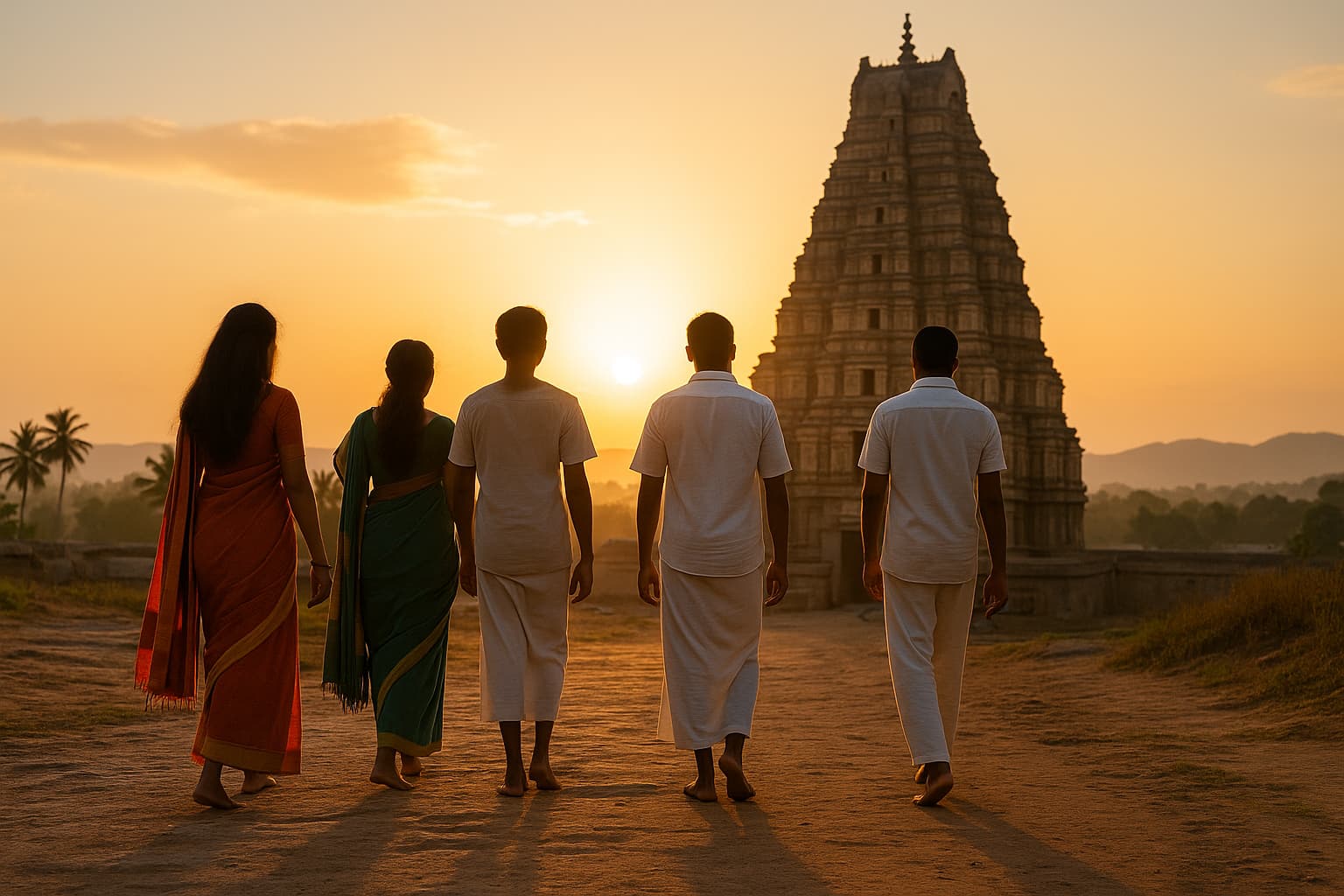Have you ever wondered why we walk to the temple, even when modern transport is easily available? In earlier times, walking was the only way to reach sacred places. But even today, the tradition continues—especially in Karnataka, where both men and women can be seen walking over 100 kilometers during temple festivals and vows. This is not just a physical journey; it is a personal offering of devotion and discipline.
Why we walk to the temple is deeply rooted in Indian spiritual thought. Each step becomes a mindful act—reminding us to slow down, reflect, and enter the divine space with humility. Walking prepares not just the body, but also the heart for darshan, making the experience more meaningful and grounded.
🚶♂️ The Spiritual Essence of Walking to the Temple
Walking to a temple isn’t a necessity in modern times, yet many devotees still choose this path with deep faith and intention. Let’s explore why we walk to the temple and what each step spiritually symbolizes:
🪔 A Journey of Devotion
Walking long distances—often barefoot—is a heartfelt expression of bhakti (devotion). Every step becomes a prayer, transforming the journey into an act of love and dedication toward the divine.🙏 A Vow Fulfilled (Harake)
Many people walk as part of a vow they made during times of struggle or prayer. It’s a personal promise kept—a walk of gratitude after blessings received.🧘 Inner Cleansing
The physical strain of walking distances releases stress, calms the mind, and sheds ego. It purifies the heart, making one more spiritually receptive.👣 Symbol of Humility
Choosing to walk instead of using modern transport reflects surrender. It reminds the devotee that status, wealth, or comfort hold no value in front of the divine.🌟 Desire to See God (Darshan)
The longing to reach the temple, see the deity, and feel divine presence motivates many to take up the walking journey—even over 100+ kilometers, as seen in Karnataka.🕉️ Cleansing of Sins (Paapa Parihara)
Some devotees believe that walking with sincere intent and prayer helps wash away past sins, allowing them to approach the divine with a lighter heart.
🗺️ Karnataka Temple Walk Map: Distance, Devotion, and Footsteps of Faith
Discover how far devotees travel—sometimes on foot—to reach Karnataka’s sacred temples.
This table highlights 15 major temples across different districts, showing their approximate distance from key cities and whether a walking pilgrimage tradition exists. From barefoot vows to community padayatras, each journey reflects a deep connection between devotion and discipline.
| Temple | District | Distance from Major City | Walking Route Known? |
|---|---|---|---|
| Dharmasthala Sri Manjunatha Temple | Dakshina Kannada | 75 km from Mangaluru | Yes, 50–100 km pilgrimage routes |
| Kollur Mookambika Temple | Udupi | 130 km from Mangaluru | Yes, during Navaratri |
| MM Hills (Male Mahadeshwara) | Chamarajanagar | 210 km from Bengaluru | Yes, forest walking path during Shivaratri |
| Savadatti Yellamma Temple | Belagavi | 85 km from Dharwad | Yes, Jatre walk tradition |
| Banashankari Temple | Bagalkot | 5 km from Badami | Short walk during Banada Hunnime |
| Chamundeshwari Temple | Mysuru | 13 km from Mysore Palace | Yes, 1000-step climb tradition |
| Siddaganga Matha | Tumakuru | 65 km from Bengaluru | No fixed walk, but common during Padayatras |
| Gavi Gangadhareshwara Temple | Bengaluru Urban | 8 km from Majestic | Yes, Sankranti padayatra tradition |
| Murudeshwar Temple | Uttara Kannada | 160 km from Karwar | Rare, but seen during Maha Shivaratri |
| Kukke Subramanya Temple | Dakshina Kannada | 100 km from Mangaluru | Yes, done as part of vows |
| Kudala Sangama Temple | Bagalkot | 90 km from Vijayapura | Walking during Allama Prabhu celebrations |
| Tirupati Balaji (via Karnataka) | Chittoor (AP border) | 250+ km from Kolar, Bangalore | Yes, padayatra by boys & women barefoot |
| Horanadu Annapoorneshwari Temple | Chikkamagaluru | 115 km from Shivamogga | Yes, mostly women walk during festivals |
| Shivamogga Sri Lakshmi Narasimha Temple | Shivamogga | 5 km from central city | Common short walk by local devotees |
🌿 Real-Life Examples from Karnataka

Karnataka holds some of the richest traditions when it comes to temple walking practices. These journeys are deeply spiritual and often done without slippers, regardless of age or gender—everyone walks with the same devotion, whether it’s boys, girls, men, or women.
🔸 Dharmasthala Temple Pilgrims
Thousands of devotees walk from Mangalore, Udupi, and nearby districts to reach the sacred Sri Manjunatha Temple in Dharmasthala. During events like Lakshadeepotsava, groups walk over 50 km barefoot, singing bhajans and chanting the Lord’s name.🔸 Male Mahadeshwara Hills (MM Hills) Trek
Devotees from Mysuru, Mandya, and Chamarajanagar take up a tough walk through forests and hill terrain to reach MM Hills Temple. This is especially observed during Mahashivaratri, where walking becomes a form of penance and self-purification.🔸 Yellamma Temple Walks
In Belagavi district, during the famous Yellamma Jatre, devotees walk barefoot for days to reach Savadatti Yellamma Temple. Many include cultural expressions like folk singing and dancing while walking, showing a blend of devotion and tradition.🔸 Karnataka to Tirupati Walks
Some devotees from Karnataka towns like Tumakuru, Chitradurga, and Bengaluru walk all the way to Tirumala Tirupati, covering 100–250 km barefoot. This is often done as a Harake (vow) to Lord Venkateshwara. These treks involve both men and women equally, proving that devotion doesn’t differentiate by gender.
🌄 The Psychological Power of the Walk
Temple walks offer more than just physical and spiritual benefits—they deeply impact the mind and emotions too. The slow, steady rhythm of walking fosters mindfulness and creates an inner calm that modern life rarely provides.
🧠 Focus & Clarity
Long-distance walking helps clear mental clutter, allowing devotees to enter the temple with a quiet, focused mind and spiritual readiness.💪 Discipline & Patience
Preparing for the journey—especially under tough conditions—builds mental endurance, patience, and emotional resilience.🤝 Connection with Community
Walking in groups creates a powerful sense of unity and shared purpose, building friendships rooted in faith and service.🌸 Detachment from Distractions
The journey away from gadgets, noise, and city rush allows people to reconnect with their inner self and focus on the divine.🧭 Sense of Purpose
Knowing that every step is part of a sacred goal boosts motivation and gives people a deeper sense of meaning and direction.
In today’s fast-moving world, where convenience often overshadows intention, temple walks remind us to slow down and realign with something deeper. Every step taken without haste becomes an act of reflection—a conscious journey toward the sacred. These walks aren’t just rituals from the past; they are living traditions that continue to ground us in humility, faith, and purpose.
So next time you visit a temple, try walking a bit beyond the usual path. Whether it’s a few extra steps or a long spiritual journey, the walk might offer more than just exercise—it might give your soul the pause and peace it has been quietly longing for.
🔗 Before your temple journey, make sure you’re dressed appropriately—read our guide on the best sarees for temple visits.
🌐 Want to know more about Karnataka’s rich temple culture? Start exploring from the KarnatakaTemple.com homepage or dive into the spiritual wonders of Hampi, a UNESCO heritage site.


